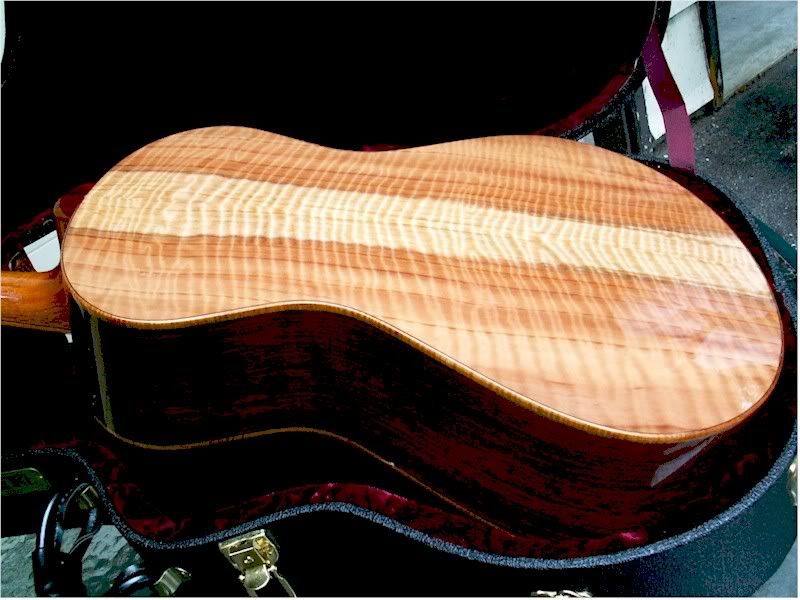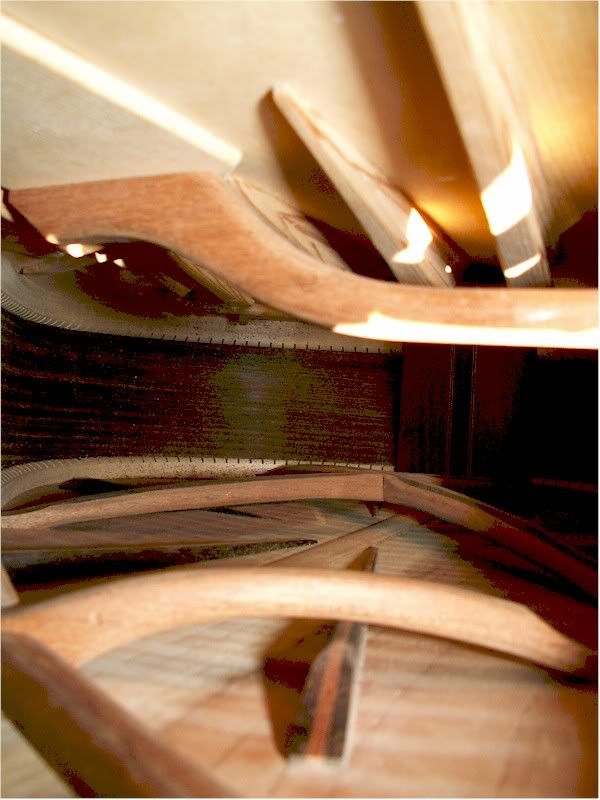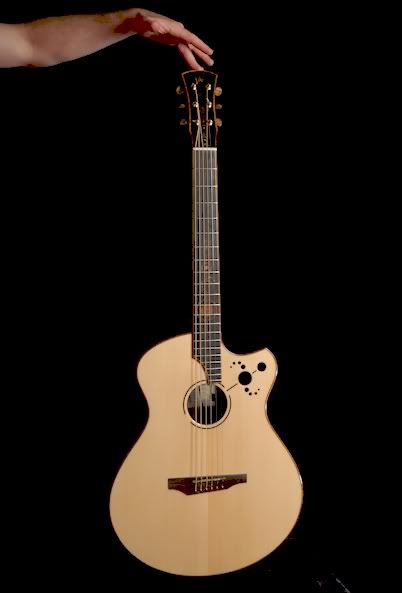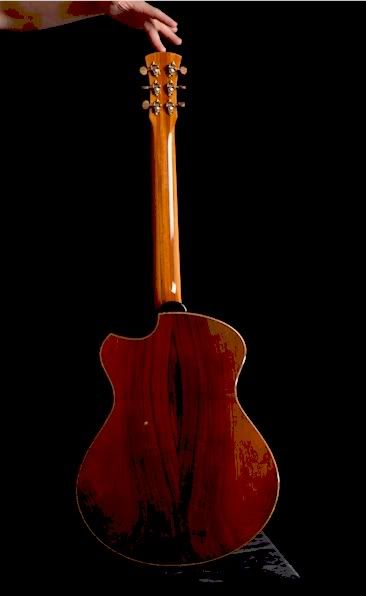
 |
|
#16
|
|||
|
|||
|
Quote:
First, your going in assumption about how the top works is not very accurate. As the strings vibrate they exert varying forces on the bridge which sends bending waves across the top somewhat like waves across a pool of water. As the waves hit the edges of the top they mostly reflect back into the top with some transmission down the sides depending on the impedance mismatch between the top and sides. At certain frequencies the waves interact, producing standing waves in the top which can be visualised using Chladni patterns. Because these are standing waves (i.e. they appear not to translate) the guitar top appears to be pumping up and down at these frequencies and the Chladni patterns show different sets of standing waves forming at different frequencies and these different forms are called modes of vibration. These modes are active not only at their resonant frequencies, but either side of them also, just not as efficiently, and the summation of all this standing wave activity is responsible for varying degrees of sound radiation at the different frequencies and consequently the peaks and troughs in a guitar's frequency response curve. The peaks are at the resonant frequencies (which I hope is sort of obvious). The top is coupled to the air cavity, the sides and the back and when that coupling takes place things get pretty complex pretty quick, so this is the simplified, short version of the story. The top excites the air inside the guitar as various parts of the top pump in and out. For the monopole modes of vibration (the top basically acting as a single piston) the enclosed air increases and decreases in pressure with top movement and at certain frequencies (approximately half the natural frequency of the top) the air cavity resonates (like a bottle does if you blow across its top) and air moves in and out of the sound hole, but mainly only at frequencies relatively close to the resonant frequencies (and a little at its first partial). These are the only frequencies of sound in the low range that escape substantially from the sound hole. For other frequencies to escape, a sound wave has to develop inside the guitar, and (apart from the sound associated with the air resonances) the lowest frequency of sound that can be established and therefore escape has a half wavelength about the same as the depth of the guitar. This occurs at ~1.5kHz and if you do enough testing (I have) you can measure this. So the concept of radiating and reflective backs is of little use; they all reflect above ~1.5kHz and none do below that frequency. For guitars with relatively flexible backs (I call them "live" backs), the pressure change in the guitar will cause the back to vibrate (not the whole story, but this is the abridged version). This colours the sound of the guitar, but because energy is being extracted from the top to make the back move the guitar looses some loudness. Having the top and back flexible also reduces the resonant frequency of the air modes, because they make the "box" appear larger (similar in effect to having a longer organ pipe). The vibrations of the back are additive to those of the top, but much above ~250Hz are out of phase with the top and so reduce sound radiation. Guitars with stiff backs don't vibrate as much, (hardly at all), appear stiffer in the coupled system and so result in higher air resonant frequencies than flexible backs, but also produce louder guitars. Very simplistically, live backs give "tone" whilst non-live back give "volume". The sides do a lot more to tone than most people think, but it is mainly the mass of the sides which changes things rather than their stiffness. Here the story gets really complicated, but the net result is that heavy sides tend to give greater loudness and projection and lower the main monopole resonant frequency of the top. Varying the mass of the sides is a great way to tweak the sound of a guitar. There's a lot of physics behind these explanations and they hold up to testing, measurement, mathematical modelling and guitar building experience. If you want the details, Google my name and look up the references. |
|
#17
|
|||
|
|||
|
That last explanation really helps explain the volume and possible loss of color hence the ability to cut of a carved back arch-top guitar with shallow stiff sides and relatively stiff back and top...
__________________
Sakazo Nakade Flamenco 1964 Bourgeois D Adi Tasmanian Blackwood 2011 Tom Anderson Strat 1990s Schecter California Classic Strat 1990s |
|
#18
|
|||
|
|||
|
I'm wondering now why a DRUM or a BANJO without any back at all seems to put out very good volume. By chance has anyone played a guitar with no back on at all?
What about a piano soundboard, without an enclosed box, sides and a sound hole? They are pretty darn loud and sound pretty darn good too :-) |
|
#19
|
|||
|
|||
|
Quote:
Quote:
Quote:
|
|
#20
|
|||
|
|||
|
I can verify what Trevor says as I have two Andrew Whites that represent the extremes of the spectrum.
My Ruby is a Kasha/Schneider inspired small bodied instrument whose Curly Redwood back is thinner than her top and has tone bars and bracing to enhance her tonal qualities. She has a soft, mellow yet well-defined voice that is so inviting that people who pick her up just can’t put her back down.    At the other end is Fast Eddie with his very dense Brazilian Rosewood back and sides. He’s warm and rich, articulate and complex. He has such sustain and gain like a volume knob that goes to 11.   Now to throw a monkey wrench into this discussion I’ll mention that I also have a deep bowl Ovation Elite who’s molded round back is designed like a parabolic reflector. 
__________________
"the Dreamer" Living life on the edge. Less crowded, better view. Ruby: Andrew White custom ordered model C Coral: Andrew White custom ordered model E Fast Eddie: Andrew White custom ordered model F Frieda: Duane Noble custom built Harp Guitar |